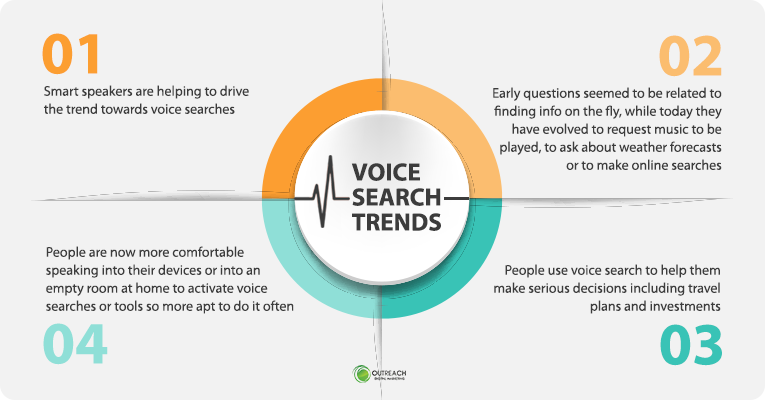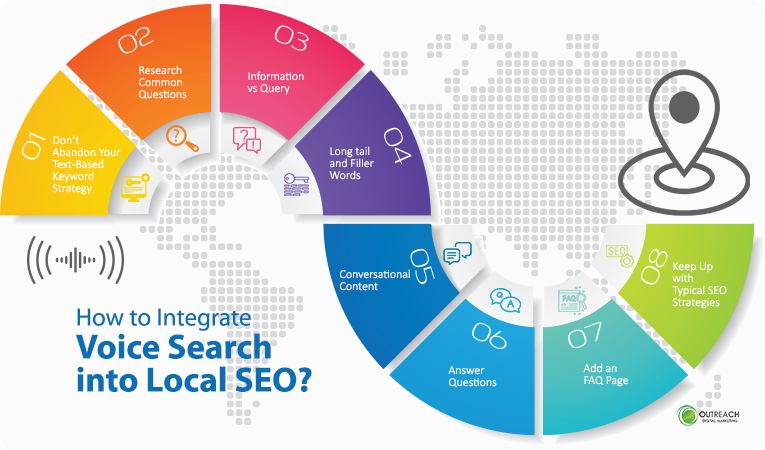The term “use your words” could become important advice for anyone conducting a search online. Speaking into a phone to make a search is easier and more natural for people. As a result, voice-activated technology is becoming more popular. The problem this poses to businesses is that people speak differently than they write.
SEO strategies need to keep up with user preference and consider how voice search will impact their favorite keywords. Here we look at the future of voice search and how you can improve your local SEO strategy to continue to meet the user’s needs.
Why Voice Search is Popular
Voice command is a tool that makes it easier for people to use smart technology. From changing the channel on a television to adjusting the temperature in your home, voice command allows people to effortlessly trigger a reaction from their devices. Digital voice assistants aren’t novel, but instead the logical next step for advancing smart technology.
As people become used to using voice command, they have naturally translated this into how they use their handheld devices, namely smartphones. With a choice of digital voice assistants, digital voice use is on the rise. Combined with smart speakers and voice command, people can use their digital voice assistants to search quickly and effectively. Add to this people’s desire to find touchless technology thanks to the pandemic and it is clear this is not the wave of the future, but the reality of the current situation.
Let’s checkout these top Voice Search statistics.
- 27% of the global online population is using voice search on mobile. (Google)
- Around 53% people use voice search while driving. (Social Media Today)
- About 21% of respondents were using voice search every week. (Search Engine Watch)
- Mobile voice related searches are 3x more likely to be local-based then text-related searches. (Social Media Today)
- HTTPS websites dominate Google’s voice search results as 70.4% of Google Home result pages are secured with HTTPS. (Backlinko)
- More than half of U.S. teens and 41% of adults use voice search on a daily basis. (Bruce Clay)
- The average voice search result is only 29 words in length which implies that Google prefers short, concise answers to voice search queries. (Backlinko)
- Around 10% of voice search queries begin as actual questions – who, what, when, where, why, how – as opposed to only 3.7% of text-based search queries. (Bruce Clay)
- PageSpeed seems to play a vital role in voice search SEO as the average voice search result page loads in 4.6 seconds. (Backlinko)
A Reliable Search Option
Since we speak as our main source of communication voice searches are far more intuitive. As more consumers discover the convenience and improved results from voice search, it is clear it will become the dominant choice for conducting searches. What businesses have to do, is to learn to adapt to the differences between words used for text-based and voice-based searches. While it might seem there wouldn’t be major noticeable differences, you will have to modify your keyword strategy to keep up with the growing popularity of voice searches.
The Near Me Voice Search
Voice search is at the heart of the near me search. These local voice searches open new opportunities for businesses like yours to improve their rankings by including keywords relevant to voice searches. Since more people are using their phones for searches compared to desktops, voice searches are going to be the search method of choice. People are already in the habit of using voice assistants to answer questions they are programmed to respond to, and can easily adapt their requests to searches. Their answers are more reliable because they are designed to search citations to find reliable sources. You can leverage near me searches by optimizing for voice searches with up-to-date consistent name, address, and phone numbers across all of your online pages from websites, to social and listings to the all-important Google My Business profile.
Voice Search Trends
Voice searches that are related to local businesses are growing. Some trends in local voice search trends include:

- Smart speakers are helping to drive the trend towards voice searches
- Early questions seemed to be related to finding info on the fly, while today they have evolved to request music to be played, to ask about weather forecasts or to make online searches
- People use voice search to help them make serious decisions including travel plans and investments
- People are now more comfortable speaking into their devices or into an empty room at home to activate voice searches or tools so more apt to do it often
As smart speakers rise it is only logical to expect voice searches will also rise. However, you also have to consider the significance of speech recognition technology. This technology is expected to be applied to further applications.
AI and Voice Searches
AI’s ability to think is helping improve online search capabilities. AI-powered devices have made it necessary for Google to create machine learning-based algorithms. You wouldn’t think technology would interfere with Google’s relevance, but the way we use devices continues to change.
As a result, Google has to reconsider its algorithms to better match the new terms people will use through voice searches. Google already considers a very important element of consumer behavior by including user intention when doing a search. This allows Google to remain more responsive as it helps determine why a user is searching, not just what they are searching. Google can use AI to then determine the type of content they wish to see. Search-based AI makes engines better by being more predictive in user intent.
This is the difference between landing on a home page or searching deeper into a brand’s web pages to find something more specific and relevant to the search terms used. AI can learn from user intent and become better and better at these predictions, so the information retrieved is more relevant.
How to Integrate Voice Search Into Local SEO
Voice technology is designed to make life easier. For voice searches, it becomes more efficient by “listening” to requests to deliver better content based on assumed user intent. So how can you leverage this intelligence for your own purposes? Is there a way to improve your SEO strategy to improve your rankings? Here are a few tips:

Don’t Abandon Your Text-Based Keyword Strategy
Don’t make the mistake of abandoning your text-based strategy. Not everyone has completely transitioned to voice search only, so you need to be responsive to the changing trend while maintaining your current keyword base. You can expect the trend to be disruptive, and maybe even to come up faster than you expect, but you still have to straddle both techniques perfectly to remain relevant. Your best strategy, therefore, is to keep up with text search keywords and learn how voice keywords work.
Research Common Questions
A big difference between voice and text search is that voice searches pose questions while text keywords do not. These low-intent questions literally ask Google outright for information, so your best strategy is to position your snippets to answer those questions. Your keyword research needs to change so you use keywords already part of your SEO strategy but in question form.
Create a list of subjects you know to be relevant to your customers, so you can come up with questions that people might logically ask related to these topics. Tools such as AnswerThePublic can help you pose questions that would be asked related to those topics. Before assuming these are questions to add to your voice search strategy, try asking Google the questions to see if they result in answers in featured snippets. This allows you to use the questions to create better answers in your snippets, so Google chooses you for your content. The better your content is at answering the question, the higher you’ll rank for that particular phrase.
Information vs Query
This ties back to intent. Consumers tend to use voice search when they want information as opposed to finding something. So someone is more likely to ask How many Emmy’s did Friends win? Then to ask Where is the closest ice cream parlor? The purpose of the questions helps you improve your local ranking because it helps you appear more relevant while also showing your prominence.
The content on your website therefore should be informative so it meets the needs of the people asking these questions. As a result, you are more likely to capture these consumers. To be featured for voice search results, you can also improve your online reviews. Google’s average star ratings are an excellent way to establish prominence as is a strong social media presence and local directories and listings.
The more you can improve your reputation through ratings, reviews and other online mentions with other local websites, the more positive your image and the more likely Google will feel you are the best option for related keyword searches.
Longtail and Filler Words
To build on your voice search strategy keep these things in mind:
- Make sure you use question-posing words including how, what, when, why, where
- Focus on long-tail keywords by posing complete questions relevant to your business and customers’ need
- Use filler words so you are forming complete sentences as mentioned so the questions remain conversational such as in, the, for, etc.
- Use descriptive words: You can also consider trying some long-tail keywords with descriptive words such as best, fastest, trendiest, latest, up to date, etc.
These tips help create questions that are human-friendly instead of text-friendly.
Conversational Content
Since voice search is more conversational, you might consider creating more content with a conversational tone to it. Rather than trying to incorporate those awkward keywords that can really interfere with the flow of your blogs, you now have the chance to make everything read more naturally which is a benefit for readers, and your blog writers!
Instead of trying to awkwardly incorporate keywords like ice cream parlor Miami, you can say what someone would normally say like ice cream parlor in Miami. You can also use words people are more likely to use in conversation that are less formal than words that sound professional and formal in your writing style — so ‘get’ instead of ‘acquire’, or ‘buy’ instead of ‘purchase’. Simpler terms come across as more conversational.
Answer Questions
Build on the answers provided in your snippets. You’ve done your best to get to the basics of the queries of voice searches, but you can expand on those snippets to satisfy Google you are an authority, while also being even more helpful to the searcher.
Make sure not to lose them once they click through to your content, by using even more questions in your keyword strategy as your sub-headings whenever possible as this also helps build SEO while allowing the reader to browse over the content quickly to both get more answers, while also encouraging them to keep reading. So you want your blogs to read something like this:
- Ask a common question for your heading
- Answer the question in the first paragraph but add more info so they understand they should keep reading
- Include subheadings with further questions, with concise answers after each question
- The entire blog should then elaborate on each answer
Basically, your goal is to build on questions and make the answers more robust.
Add an FAQ Page
What easier way to include questions and answers that Google will love than to create an FAQ page. Use every question your research found and you’ll be providing the exact keywords people are likely to use for their voice searches.
Keep Up with Typical SEO Strategies
Along with your text-based keywords, continue to keep up with typical local keyword strategies. This includes:
Fast Loading Time: People are impatient and won’t wait for a slow website to load. To improve loading speed you can:
- Compress images and videos
- Reduce JavaScript parsing
- Use CSS3 and HTML5 framework for quicker mobile loading
- Reduce redirects
- Use a Content Delivery Network (CDN)

These tips will improve load speeds as well as your rankings.
Be Mobile Friendly: Google looks for websites that are designed for mobile use. Because voice searches are more frequently made by mobile devices, it makes sense your site is responsive and will adapt to the device people use for their search. To be sure your site is mobile-responsive, try to load your website using your phone and look for bugs.
Complete Your Google My Business Profile: Voice near me searches are local searches and therefore you want to be recognizable as a local business. Optimize your Google My Business profile by including your complete Name, Address, and Phone Number (NAP) and be sure you choose the right business category. Don’t forget little details such as your area code and always keep your profile up to date. Whether you have a Google business listing or not, go through your profile and use every single feature available, and also complete every single section as completely as possible.
Use Local Geo Keywords: Make sure you include your location throughout your website content. Make blogs more relatable to locals by using their town name, and even relating to local terms for your neighborhood.
These basic local SEO tips will keep you more prominent for local voice searches.
Is your business keeping up with SEO trends? We can help you stay on the cutting-edge with our personalized digital marketing strategies. Call us today.
